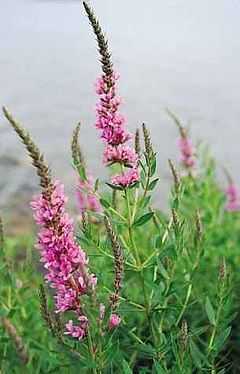Lythraceae
| Lythraceae | |
|---|---|
 | |
| Lythrum salicaria | |
| Scientific classification | |
| Kingdom: | Plantae |
| (unranked): | Angiosperms |
| (unranked): | Eudicots |
| (unranked): | Rosids |
| Order: | Myrtales |
| Family: | Lythraceae J.St.-Hil.[1] |
| Genera | |
|
31 (27); see text. | |
The Lythraceae are a family of flowering plants, including about 620 species of mostly herbs, with some shrubs and trees, in 31 genera.[2] Major genera include Cuphea (275 spp.), Lagerstroemia (56), Nesaea (50), Rotala (45), and Lythrum (35).[3] Lythraceae have a worldwide distribution, with most species in the tropics, but ranging into temperate climate regions, as well.
The family is named after the type genus, Lythrum, the loosestrifes (e.g. Lythrum salicaria purple loosestrife) and also includes henna (Lawsonia inermis). It now includes the pomegranate, formerly classed in a separate family Punicaceae. The family also includes the widely cultivated crape myrtle trees. Botanically, the leaves are usually in pairs (opposite), and the flower petals emerge from the rim of the calyx tube. The petals often appear crumpled.
Characteristics
The Lythraceae are most often herbs, and less often shrubs or trees; the shrubs and trees often have flaky bark.[4] Traits shared by species within the Lythraceae that distinguish them from belonging to other plant families are the petals being crumpled in the bud and the many-layered outer integument of the seed.[3]
Leaves
The leaves generally have an opposite arrangement, but sometimes are whorled or alternate. They are simple with smooth margins and pinnate venation.[3] Stipules are typically reduced, appearing as a row of minute hairs,[3] or absent.[4]
Flowers
The flowers are bisexual, radially or occasionally bilaterally symmetric, with a well-developed hypanthium. The flowers are most commonly four-merous but can be six-merous, with four to eight sepals and petals. The sepals may be distinct, partially fused to form a tube, or touching without overlapping. The petals are crumpled in the bud and wrinkled at maturity, and are typically distinct and overlapping; they are occasionally absent.[3] There are usually twice as many stamens as petals, arranged in two whorls, and the stamens are often unequal in length. Occasionally, the stamens are reduced to one whorl, or are more numerous with multiple whorls.[2] The ovary is typically superior, infrequently semi-inferior,[5] or rarely inferior. The two to many carpels can be fused together (syncarpous), with two to numerous ovules in each locule, with axile placentation of the ovules.[3]
Heterostyly – the presence of two (distylous) or three (tristylous) distinct flower morphs within a species differing in the lengths of the pistil and stamens – is common within the Lythraceae.[3]
Gallery
-

Crape myrtle
-

Crape myrtle flowers - the petals emerge from the calyx tube.
-

Rotala species
Genera
Lythraceae has 31 genera in five subfamilies:
- Subfamily Punicoideae (Horan. 1834) S. A. Graham, Thorne & Reveal 1998 = 'Punicaceae',[6] 1 genus:
- Subfamily Duabangoideae (Takht. 1986) S. A. Graham, Thorne & Reveal 1998 = 'Duabangaceae',[6] 1 genus:
- Subfamily Trapoideae Voigt 1845 = 'Trapaceae', 1 genus:
- Trapa
References
- ↑ Angiosperm Phylogeny Group (2009). "An update of the Angiosperm Phylogeny Group classification for the orders and families of flowering plants: APG III" (PDF). Botanical Journal of the Linnean Society 161 (2): 105–121. doi:10.1111/j.1095-8339.2009.00996.x. Retrieved 2013-07-06.
- ↑ 2.0 2.1 Stevens, P.F. (2001 onwards). "Angiosperm Phylogeny Website". Retrieved 15 February 2011.
- ↑ 3.0 3.1 3.2 3.3 3.4 3.5 3.6 Judd, Walter S.; Christopher S. Campbell, Elizabeth A. Kellogg, Peter F. Stevens, & Michael J. Donoghue (2008). Plant Systematics: A Phylogenetic Approach (3rd ed.). Sunderland, MA: Sinauer Associates. pp. 412–414. ISBN 978-0-87893-407-2.
- ↑ 4.0 4.1 Mabberley, David J. (2008). Mabberley's Plant Book: A portable dictionary of plants, their classification and uses (3rd ed.). Cambridge: Cambridge University Press. p. 508. ISBN 978-0-521-82071-4.
- ↑ Graham, Shirley; Cavalcanti, Taciana B. "Neotropical Lythraceae". Royal Botanic Gardens, Kew. Retrieved 28 March 2011.
- ↑ 6.0 6.1 6.2 Graham, S. A., R.F. Thorne, & J.L. Reveal (1998). "Validation of subfamily names in Lythraceae.". Taxon 47 (2): 435–436. doi:10.2307/1223775. JSTOR 1223775.
Further reading
| Wikimedia Commons has media related to Lythraceae. |
| Wikispecies has information related to: Lythraceae |
- Little S. A., Stockey R. A., and Keating, R. C. (2004). "Duabanga-like leaves from the Middle Eocene Princeton chert and comparative leaf histology of Lythraceae sensu lato". American Journal of Botany 91 (7): 1126–1139. doi:10.3732/ajb.91.7.1126. PMID 21653468.
- Carr, Gerald. "Lythraceae". University of Hawaii. Archived from the original on 2008-12-05. Retrieved 2008-12-20.
- Lythraceae in L.Watson and M.J.Dallwitz (1992 onwards). The families of flowering plants: descriptions, illustrations, identification, information retrieval.



